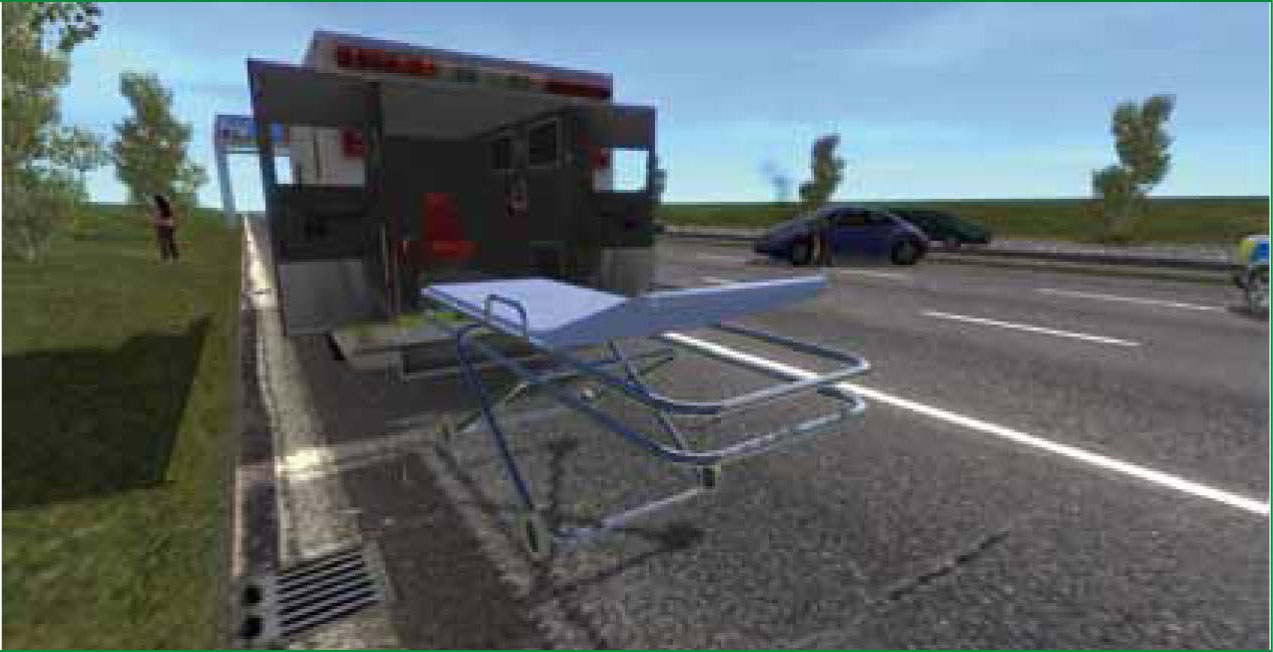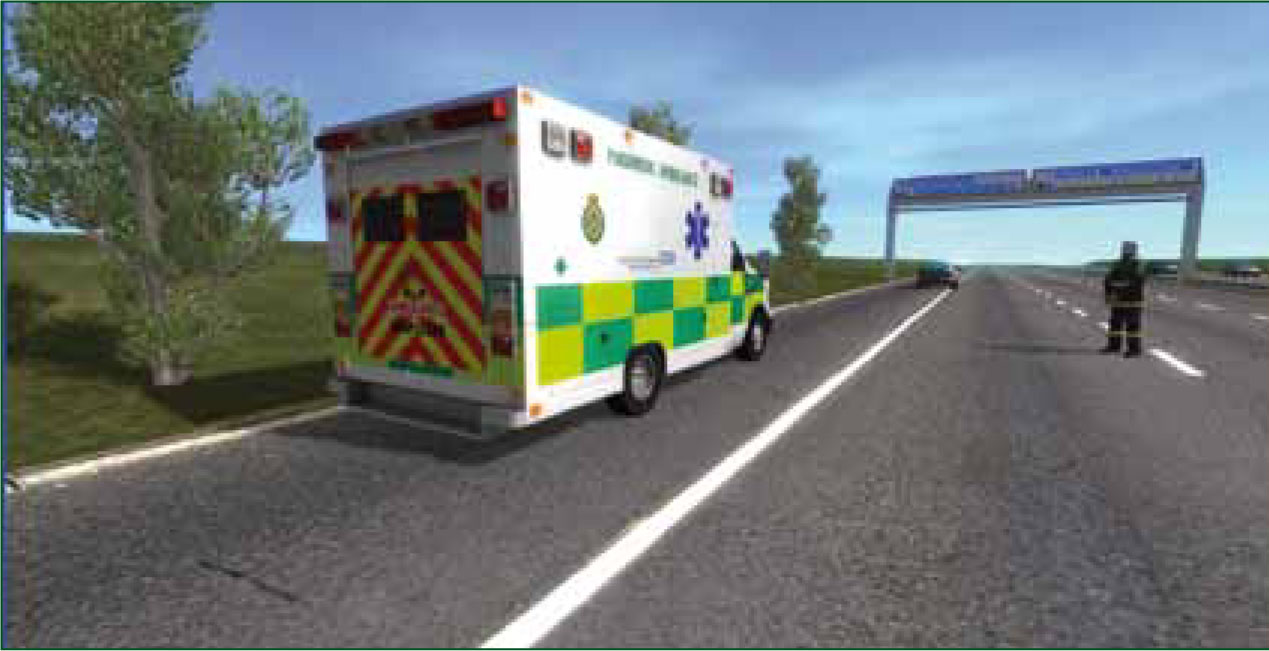Virtual simulation software was designed and a workshop run for a mix of year two BSc honours and year one foundation degree paramedic students, with a focus on scene management. The key aims of the project were
The value of this learning, through the use of virtual scenarios, is that the students can practice in an environment that would be difficult to produce in real life. The work of researchers such as Knight et al (2010) suggest that virtual technologies offer the potential to enhance learning and improve subsequent performance when compared to traditional educational methods and Parvati et al (2007), who examined virtual training in anaesthetics, consider that the opportunities are immense for the use of virtual worlds in training for optimal performance and error reduction.
Simulation is situated within experiential learning, which is seen as an important part of professionally orientated degree programmes and can provide educators with an experiential teaching strategy (Cioff, 2001; Beaty, 2007).
Virtual paramedic scene management software and workshop
The simulated scene scenario consisted of a two car road traffic collision on a dual carriageway, involving three casualties. The casualties’ simulated conditions ranged from critically and moderately injured to ‘walking wounded’. Students worked in pairs using computer terminals remote from the ‘ambulance control centre’ each with an avatar (on screen character) to immerse themselves into the virtual reality to make up the ambulance crew responding to the incident. Using headsets, the students could communicate face-to-face with each other and other professionals in the virtual scene and communicate with the control centre as in real life.
A fire chief avatar was acted by a member of the teaching staff and also, already at the incident, other individuals comprised the three casualties, fire crews and police officers. The aim for the paramedic crew was to manage the scene and provide the appropriate clinical care for the casualties. It is usual in simulation to endeavour to make the situation as ‘high-fdelity’ (realistic as can be achieved) as possible and while in a virtual reality environment, the use of real individuals in real-time added to this.
For example, one of the first problems for the students to deal with on approach to the scene was traffic and a police car blocking access to the scene. The police could move this to allow access so that the ambulance could be parked ready for egress, but the students would have to make that request. The lack of a supporting crew was perhaps not necessarily realistic, but did provide another challenge for the students (and the students did make repeated requests).
Key elements that were hoped to be addressed within the structure of this scene management scenario were communication, team working, patient management, critical thinking and decision-making. The workshop also encouraged the students to develop competence in observational skills, peer-feedback and to gain a deeper knowledge of the team working dynamic under challenging clinical conditions.
The simulation allowed the students to enter a realistic virtual environment, which can replicate many components that would be at a real scene, including people, buildings, vehicles and environmental conditions, e.g. night or day and weather conditions. The students could then interact with the environment, communicating with other individuals at the scene, use equipment and move around as in the real world.
A cornerstone of paramedic practice is to be able to think and work under pressure (Pilbury, 2008) and the scenario was designed to challenge the students in this way. Cioff (2001) suggested that the use of simulation has the potential to provide learners with a safe environment for learning. An advantage of simulation is that students can be allowed to make mistakes in this controlled arena (Ziv et al, 2000).
Feedback and peer review
Each of the student pair's scenarios were recorded and then played back to the group for discussion. The scenarios provided the students with opportunities to develop the giving and receiving of peer feedback and the debriefings encouraged the practice of refection and discussion.
It is hoped that this method will add to current formative assessment and feedback processes. Also, the students were introduced to the concept of crew resource management, which was developed in the aviation industry, and has been successfully adapted for medical environments, being concerned with approaches towards stress, hierarchy, teamwork and error (Helmreich et al, 1999).
Finally, the whole group discussed what might be necessary to document following this incident as it is recognized that high quality record keeping and documentation is linked to quality patient care (Gregory and Murcell, 2010). The students performed the scenarios well, given their stage of development, but there were enough areas for potential development for discussion and refection within the group and for the students to gain knowledge from the experience. There were no issues regarding usability of the system from the students’ perspective.
The students managed to handle the functional technology well with only five minutes of training and instruction, and none expressed any concerns. It is hoped that this experience has provided tangible outcomes for these students to develop their roles in future professional practice.
Future development
The team evaluated the processes and outcomes to consider wider applications within paramedic and other programmes, with a particular view to developing collaborative working relationships across disciplines and schools within UH. These scenario workshops used a ‘sandbox’ technique which means the events are run in real time and are fluid and flexible for both the participants and the facilitators.
Different software, with simpler scenarios, or more clinically orientated content, can use algorithms for set pathways, which could be then used in a distance learning context.
Conclusion
The advantage of virtual environments is that there are limitless variations for the designers and teaching staff to create. However, from a teaching perspective, this methodology is quite labour intensive; as had been noted in the Brannan et al (2008) study, which highlighted that the development and implementation of simulation experiences requires substantially greater use of resources in terms of time, compared with traditional pedagogic approaches.
It is possible to set simpler scenarios in the software with a variety of drop down boxes rather than live interaction, but some of the richness would be lost, making the scenarios more rigid due to the element of improvisation taken away. The original intention of the project design was to use ‘UNITY’ software. The screen shots (Figures 1, 2, 3 and 4) are in that format taken from our early designing and it can be seen that the avatars are very realistic and the environmental rendering (graphics) likewise is of very high quality. Though the scene environment and simulation plan remained the same, we had to switch from the Unity software to setting up a Second Life world to work in, as this was more manageable from a programming perspective.




Some of the quality was altered due to this, yet this was probably more of an issue for the project team than the students. Evaluation showed that the students enjoyed the workshop and felt it had been a very worthwhile learning experience. They expressed a desire to participate in more of the same in the future if offered.
